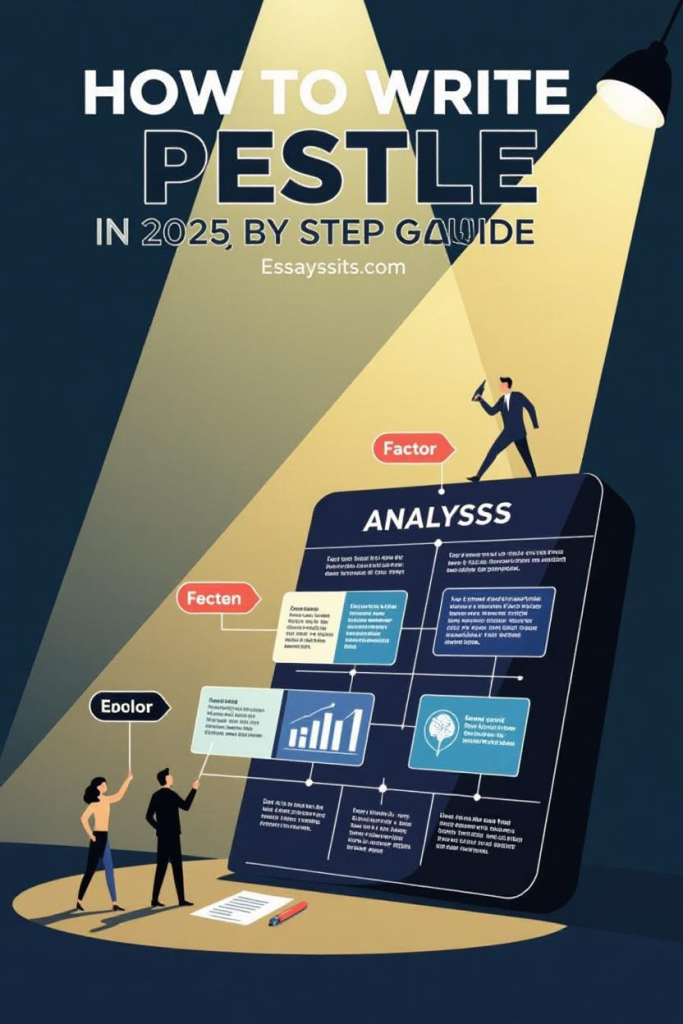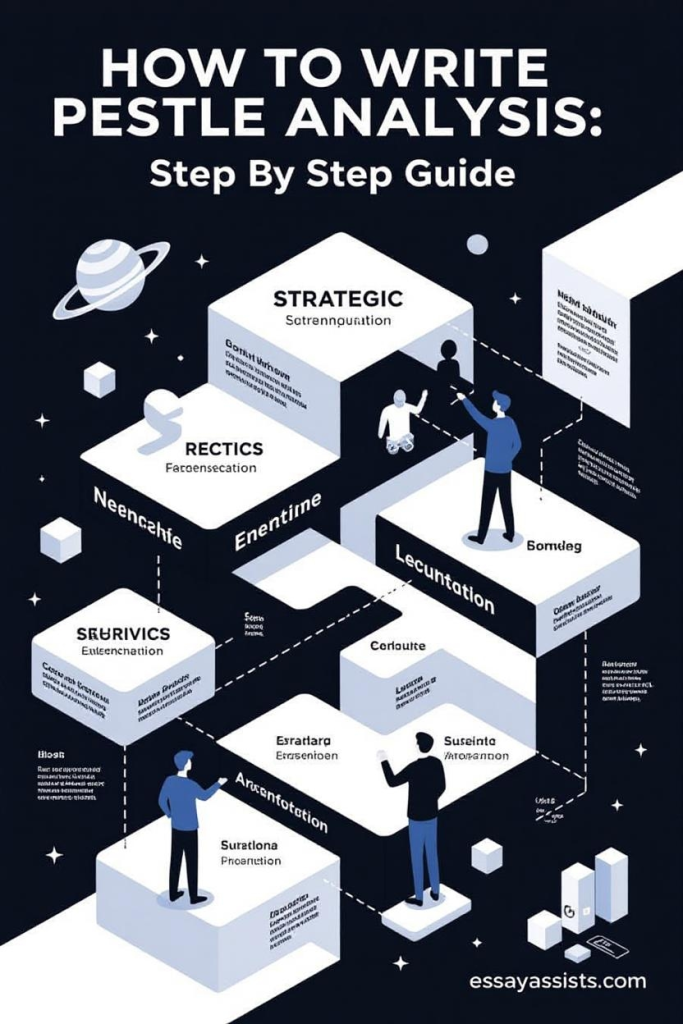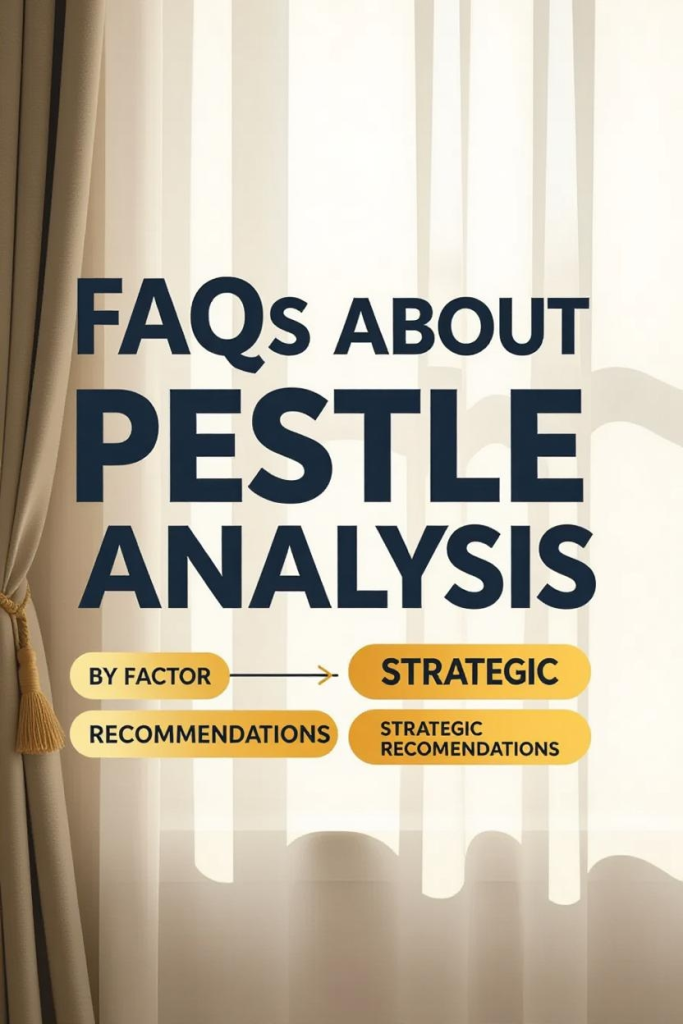
A PESTLE analysis is an essential tool for businesses, students, and professionals who want to understand the macro-environmental factors that can impact an organization or project. By examining Political, Economic, Social, Technological, Legal, and Environmental influences, you gain a comprehensive perspective on external factors that may shape your decisions. This step-by-step guide will help you write a PESTLE analysis effectively.
At Essayassists.com, we help students get safe, transparent, and professional writing help.
Step 1: Understand the Purpose of PESTLE Analysis
Before you start your PESTLE analysis, it’s essential to understand why this tool is important. PESTLE helps you evaluate the external macro-environmental factors that could impact an organization, project, or industry. By analyzing Political, Economic, Social, Technological, Legal, and Environmental elements, you gain a clear picture of potential opportunities and threats.
The main purposes of a PESTLE analysis are:
- Identify Opportunities and Threats:
Understanding external factors helps you spot market opportunities and anticipate challenges before they affect your business. - Support Strategic Decision-Making:
By analyzing how these factors interact with your business, you can make informed, proactive decisions rather than reacting to changes. - Understand Market Dynamics:
PESTLE provides insight into trends, regulations, and social changes that can influence customer behavior and industry standards. - Align Business Strategies:
It ensures your strategies are in tune with the wider environment, helping your organization stay competitive and resilient.
Key Tip: Always keep the purpose in mind throughout your analysis. Focus on factors that genuinely impact your organization or project rather than listing every possible external factor. This ensures your PESTLE analysis is practical, actionable, and relevant.
Step 2: Gather Relevant Data
Once you understand the purpose of your PESTLE analysis, the next step is to collect accurate and relevant data. The quality of your analysis depends entirely on the reliability of the information you gather. Without proper data, your conclusions may be misleading or incomplete.
Where to Find Data for Each PESTLE Factor
- Political Factors
- Government websites and official publications
- Policy updates, tax regulations, and trade agreements
- News outlets covering political events and stability
Example: Researching new labor laws or international trade restrictions that might affect your business operations.
- Economic Factors
- Central bank reports and economic indicators (inflation, interest rates)
- Industry-specific market reports
- Financial news and forecasts
Example: Identifying how a recession could impact consumer spending in your industry.
- Social Factors
- Demographic data from census reports
- Surveys on cultural, lifestyle, and consumer trends
- Academic research on social behavior
Example: Understanding shifts in consumer preferences toward eco-friendly products.
- Technological Factors
- Technology news sites and innovation reports
- Industry journals and patent databases
- Research & development updates from competitors
Example: Evaluating how AI or automation can improve efficiency or disrupt your business model.
- Legal Factors
- Government regulations and official legal notices
- Industry compliance standards and labor laws
- Intellectual property and data protection regulations
Example: Monitoring new data privacy laws that affect customer information handling.
- Environmental Factors
- Environmental impact reports and sustainability studies
- Climate change publications and ecological surveys
- Corporate social responsibility reports from competitors
Example: Assessing how stricter environmental regulations may influence your production processes.
Tips for Gathering Data
- Use credible sources: Government publications, industry reports, and academic journals are highly reliable.
- Stay current: PESTLE factors can change rapidly, so use the most recent information.
- Be selective: Focus on factors relevant to your specific industry or organization to keep the analysis actionable.
Key Tip: Keep a well-organized record of your sources and findings. This makes it easier to reference your data later and ensures your analysis is transparent and trustworthy.
Step 3: Break Down the Analysis by Factor

1. Political Factors
These include government policies, stability, tax regulations, trade restrictions, and political trends that could impact your business.
Example: Changes in tax laws may affect profitability, while new trade agreements could open markets.
2. Economic Factors
Economic factors refer to the broader economy’s impact on your organization, such as inflation rates, unemployment, interest rates, and economic growth.
Example: A recession may reduce consumer spending, affecting sales.
3. Social Factors
Example: An aging population might increase demand for healthcare products.
4. Technological Factors
This includes technological innovations, automation, R&D activity, and digital transformation affecting your industry.
Example: The rise of AI and automation can improve efficiency but also disrupt traditional job roles.
5. Legal Factors
Legal factors encompass laws and regulations affecting operations, including labor laws, consumer protection, health and safety, and intellectual property rights.
Example: New data privacy regulations may require changes in how a company handles customer information.
6. Environmental Factors
These factors relate to ecological and environmental aspects like climate change, sustainability, waste management, and carbon footprint regulations.
Example: Increasing emphasis on green practices can affect production processes and brand reputation.
Step 4: Analyze the Impact
After identifying and categorizing factors in your PESTLE analysis, the next crucial step is to evaluate their significance. Not all factors have the same level of impact, so analyzing them helps prioritize your focus and make strategic decisions.
- Determine the Effect
Ask yourself how each factor could affect your organization:- Is it an opportunity or a threat?
- Will it have a short-term or long-term impact?
- Which areas of your business are most affected (finance, operations, marketing, HR)?
Example: A rise in minimum wage may increase labor costs (threat) but also improve employee satisfaction (opportunity).
- Assess Probability and Severity
Not all factors are equally likely to occur or have the same consequences. You can:- Score each factor based on likelihood (high, medium, low)
- Score each factor based on impact (major, moderate, minor)
This helps prioritize which factors demand immediate attention.
- Look for Interconnections
Some factors may influence others. For example:- Economic downturns may trigger social changes, such as shifts in consumer spending.
- Technological advancements may require legal compliance updates.
- Visualize the Analysis
Using tools like a matrix, table, or chart can make the evaluation clearer:
| Factor | Opportunity/Threat | Likelihood | Impact | Priority |
| Rising tech innovation | Opportunity | High | Major | High |
| New environmental regulations | Threat | Medium | Major | High |
| Aging population | Opportunity | High | Moderate | Medium |
Key Tip:
Be objective when analyzing factors. Avoid overestimating minor issues or underestimating major trends. Focus on the factors that can truly influence your strategic decisions.
After analyzing the impact of each factor, the next step is to present your PESTLE analysis clearly and effectively. A well-structured presentation ensures that your insights are actionable and easy to understand for decision-makers or readers.
Ways to Present Your Findings
- Table Format
A table provides a clear, organized view of each factor, its impact, and priority. For example:
| Factor | Opportunity/Threat | Likelihood | Impact | Priority |
| Technological innovation | Opportunity | High | Major | High |
| Regulatory changes | Threat | Medium | Major | High |
| Changing consumer trends | Opportunity | High | Moderate | Medium |
Tables are easy to scan and help stakeholders quickly grasp key insights.
- Narrative Report
Write a descriptive summary for each PESTLE category. Include:- Key factors identified
- Their potential impact
- Recommendations based on the analysis
Example: “Rising environmental regulations pose a moderate threat to our production process. Investing in green technologies now will mitigate future risks and improve brand reputation.”
- Visual Charts or Infographics
Visuals make complex information digestible:- Bar or pie charts to show factor priority
- Heat maps to indicate likelihood vs. impact
- Infographics to summarize opportunities and threats
Visuals are particularly effective for presentations or reports to leadership teams.
Key Tip:
Choose the format that best suits your audience. Executives may prefer visuals and concise tables, while academic or detailed business reports may benefit from a narrative format. The goal is to communicate insights clearly and persuasively..
Step 6: Make Strategic Recommendations

The final step in writing a PESTLE analysis is to translate your findings into actionable strategies. Identifying factors is useful, but the real value comes from using this information to make informed decisions and prepare for future challenges.
How to Make Strategic Recommendations
- Address Threats
Determine how to mitigate risks posed by external factors. Ask yourself:- How can we reduce negative impacts?
- Are there preventive measures we can implement?
Example: If new environmental regulations threaten production costs, invest in eco-friendly technology or revise manufacturing processes to comply.
- Leverage Opportunities
Look for ways to capitalize on positive trends. Ask:- How can we take advantage of emerging markets or technologies?
- Which social or economic trends can increase our competitive advantage?
Example: Rising demand for health-conscious products may prompt the launch of a new organic product line.
- Prioritize Actions
Not all factors require immediate action. Use your earlier analysis to focus on high-priority items first:- High-impact, high-likelihood factors should be addressed immediately.
- Medium-impact factors can be monitored and planned for.
- Align with Business Goals
Ensure your recommendations support the overall objectives and strategy of your organization. Strategic alignment makes your analysis practical and implementable. - Monitor and Update
PESTLE analysis is dynamic, as external factors can change rapidly. Regularly revisit your analysis and adjust strategies accordingly.
Key Tip:
Effective strategic recommendations are specific, realistic, and actionable. Avoid vague advice like “adapt to new trends”; instead, outline clear steps, timelines, and responsible teams.
✅ With Step 6 complete, your PESTLE analysis blog now provides a full, step-by-step guide from understanding the purpose to implementing actionable strategies.
Tips for Writing an Effective PESTLE Analysis
Creating a PESTLE analysis that is insightful and actionable requires more than just listing factors. Here are some expert tips to ensure your analysis is accurate, practical, and valuable:
1. Be Thorough but Focused
While it’s tempting to include every possible factor, focus on those that truly impact your organization or project. Avoid cluttering your analysis with irrelevant details.
2. Use Credible Sources
Reliable data is essential. Use government reports, industry publications, market research, and academic studies. Always double-check facts to ensure accuracy.
3. Stay Current
PESTLE factors are dynamic. Economic conditions, regulations, and social trends can change quickly. Make sure your data is up-to-date to maintain relevance.
4. Quantify Where Possible
Whenever feasible, use numbers, statistics, or measurable indicators to support your analysis. This makes your findings more objective and persuasive.
Example: Instead of saying “rising interest rates may affect sales,” specify “a 1% increase in interest rates could reduce consumer spending by 3%.”
5. Be Objective
Avoid letting personal opinions or assumptions skew your analysis. Evaluate each factor impartially, considering both potential risks and opportunities.
6. Highlight Opportunities and Threats
Clearly distinguish between factors that could benefit your organization and those that could pose risks. This helps in strategic decision-making.
7. Use Visuals and Tables
Tables, charts, and infographics make your analysis easier to understand and more engaging. They allow readers to quickly grasp key insights.
8. Link to Strategy
Always connect your analysis to actionable steps. A PESTLE report is most valuable when it guides decisions, informs strategies, or supports planning.
9. Review and Update Regularly
A PESTLE analysis is not a one-time task. Regularly revisit your analysis to reflect changes in the external environment and adjust your strategies accordingly.
These tips ensure that your PESTLE analysis is not just a theoretical exercise but a practical tool for decision-making.
Writing a PESTLE analysis may seem complex at first, but by following these steps, you can produce a clear, insightful, and actionable report. It allows businesses and students alike to anticipate challenges, seize opportunities, and make data-driven decisions in a rapidly changing environment.
Start today by collecting information, breaking it into the six PESTLE categories, analyzing the impact, and using your findings to create strategies that work.

1. What is PESTLE analysis?
PESTLE analysis is a strategic tool used to evaluate external macro-environmental factors that can impact an organization or project. It examines Political, Economic, Social, Technological, Legal, and Environmental influences.
2. Why is PESTLE analysis important?
It helps businesses and students:
- Identify opportunities and threats in the market
- Make informed strategic decisions
- Understand market trends and consumer behavior
- Align business strategies with external factors
3. How do I start a PESTLE analysis?
Start by understanding the purpose of your analysis, then gather relevant data from credible sources. Next, break the information down into the six PESTLE categories and evaluate each factor’s impact.
4. What sources are best for PESTLE analysis?
Reliable sources include:
- Government and official reports (for political and legal factors)
- Financial and economic publications
- Market research studies
- Academic journals
- Industry reports and technological news
5. How often should PESTLE analysis be updated?
Since external factors are constantly changing, it’s recommended to review and update your PESTLE analysis regularly, ideally every 6–12 months or whenever significant changes occur in your industry.
6. Can PESTLE analysis be used for small businesses?
Yes! PESTLE is valuable for businesses of all sizes. Even small businesses can use it to understand market trends, identify potential risks, and make informed decisions.
7. What is the difference between PESTLE and SWOT analysis?
- PESTLE focuses on external macro-environmental factors affecting the business.
- SWOT analyzes both internal strengths and weaknesses and external opportunities and threats.
Many organizations use both tools together for a complete strategic overview.
8. How do I make PESTLE analysis actionable?
After identifying and analyzing factors, create strategic recommendations that:
- Mitigate threats
- Leverage opportunities
- Prioritize high-impact factors
- Align with business goals
